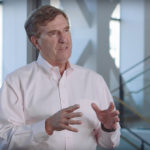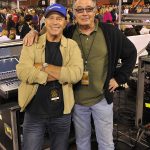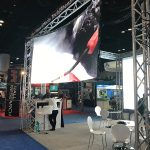He was the voice of Woodstock, gently suggesting you avoid the brown acid.
Chip Monck is one of the most colorful characters in the business, a business he is considered the Godfather of. The lighting designer has been part of some of the amazing events ever staged, including the Ali/Foreman “Rumble in the Jungle” in Zaire (now Democratic Republic of the Congo). He was tour and staging manager with the Rolling Stones for seven years and stage producer for Concert for Bangladesh at Madison Square Garden, one of the first big benefit concerts raising awareness and donations.
In the early 1960s, he worked at the Apollo Theatre in Harlem, lighting legends including Chuck Berry, Dizzy Gillespie and Maynard Ferguson. He was working Newport when Bob Dylan went electric and at the riotous Altamont Free Concert. Others he worked with include Bette Midler, Paul Anka and Barry White. He even lit Pope John Paul II’s historic Mass at Dodger Stadium in 1987. In 2003, he received the Parnelli Lifetime Achievement honor, though that hardly slowed him down.
One Great Night
Currently he’s working with Lyndel Moore and is director of production of One Great Night on Earth. Conceived as a 10-year series of one day, 12-hour festivals on 900 acres of private land less than an hour’s drive from Melbourne, the first concert is set for Dec. 1, 2012. The goal is to help raise funds — between $14 million and $16 million Australian each year — for those affected by natural disasters. Monck is putting his formidable skills and experience to work to ensure a quality experience for the crowds, which are projected at 100,000.
He says that part of the inspiration is the surprising fact that Australia currently relies heavily on internationally-raised fund in times of need. Fine Green Paddock, a charity founded by Australians, for Australians, helping those affected by natural disasters. By next year, they hope to expand the One Great Night concept beyond their continent to the U.S. and the U.K. “It’ll be a blueprint,” he says of the event.
Monck will be overseeing 12 hours of rock on a stage replicated from the one he put together at Woodstock in 1969. He’s reached out to old friend John Brown of Brown United in Los Angeles to supply it.
“During a meeting mid 2010, a colleague suggested I make contact with Chip Monck,” says Moore. “I have always been a great fan of Chip’s work,” Moore adds, noting her surprise when Monck agreed to her request for assistance (though those that know him aren’t the least bit surprised).
The Nickname
Edward Herbert Beresford Monck was born on March 5, 1939 in Wellesley, MA. As a kid in summer camp, some wiseacre started calling him Chip, and the nickname stuck.
As a teen, he fell into a summer theater group that performed at nearby Wellesley College. Working behind the scenes while the group did the classics, it was there he met his tutor, Greg Harney, a lighting director who would later become technical director of PBS’ flagship station, WGBH Boston.
“Greg taught me to break down a fitting, repair it, realign it, focus it and make it work for just a night or a week, depending on whether or not the company could afford to pay for spare parts,” Monck says. At the theater, he learned the basics, including how to operate the dimmer board. Next, he audited a few classes at Harvard while working with the school’s theater company. He also cut a deal with the theater department, using its staging for fraternities’ events on campus.
When driving a Harvard production of a Gilbert & Sullivan show to New York in 1959, Monck found himself at the historic Village Gate nightclub. “I walked into the Gate and saw that it had a leak by the door,” Monck recalls. “I told them I could fix the leak.” Soon he was lighting a small play they were doing, and that led to other things, but these were lean times. Monck laughs and tells that he got $1.87 for each show, coming to a grand total of $16.83 a week, but “I could eat and drink there, too.” Bartering his burgeoning technical skills was a necessary survival tool during that period.
By the following year, he had hooked up with Charles Altman of Altman Lighting, and the two became fast friends. “I started working with the old man on the benches,” Monck says. “I used to go up to his place on my Yamaha 250 motorcycle, then take Fresnels and put them on the handlebar of the bike and put the cables over our shoulders and drive back to Manhattan. I borrowed all kinds of [equipment] from Altman and tried it out at the Gate. They eventually liked the well-lit look and started buying from him.”
Soon he was also doing shows at the Apollo and working the Newport Jazz Festivals. In 1967, he did the Monterey Pop Festival, got to L.A. and lit The Byrds at Hollywood Bowl and most important, did his first Stones show in Boston. The following year, it was Crosby, Stills & Nash in Europe.
 Woodstock
Woodstock
Monck had, by the late 1960s, established himself with Bill Graham and was often hired to do his shows. Then came Woodstock. For the 10-week gig, Monck would get a mere $7,000. What many don’t realize is that Woodstock was originally to be held on another farm, but the organizers were kicked off that land and had to set up on Max Yasgur’s farm for the event. So there was an entire lighting design that never got put up because they ran out of time to put the roof on the stage. Scores of lights sat under the stage, unused.
At the last minute, producer Michael Lang realized he had no emcee and told Monck to do it — he was petrified. So there he is, in the Woodstock documentary, making the infamous announcement:
“The warning that I’ve received, you might take it with however many grains of salt you wish, that the brown acid that is circulating around is not specifically too good. It is suggested that you stay away from that. But it’s your own trip, be my guest. But please be advised that there’s a warning, okay?”
Altamont
Up next was Altamont, conceived as a “Woodstock West,” which also challenged its planners with enormous changes of venue at the last minute. The decision to stage the event at Altamont Speedway wasn’t final until Thursday, Dec. 4. The concert took place on Saturday Dec. 6, 1969.
The Hells Angels, stationed to keep the rowdy crowd off the meter-high stage, soon joined in the mind-altered melee, and although one of the bikers was charged for stabbing and killing a gun-brandishing fan, he was later acquitted. When Monck caught one of the gang members taking the custom-made stage carpet, and he spoke up against it, the biker’s rebuttal came in the form of the butt of a pool cue, knocking out a few of Monck’s teeth. Monck, not one to give up, tracked down the stolen soft goods and negotiated its return with a case of brandy.
“I was entranced [by Monck], because he’s very flamboyant and already had this reputation of being a conceptual genius,” says Patrick Stansfield, renowned production manager and a Parnelli honoree himself. He worked with Monck often, including with the Stones. “I was bowled over by him and his mastery of technical terms.”
Stansfield still can see Monck stalking the spot operators and shouting out cues, then on stage, at the piano, cueing from there. Specific cues are still vivid. “Going into ‘Street Fighting Man,’ we had a big truss with probably 100 PAR-cans with gels, on a hydraulic lift,” Stansfield recalls. “The lift would bring down the lights, and we’d skitter on and pull the gels off [by hand], so when it went up again, it would all be blazing white. It was a huge effect, a big part of the show… a pre-technical color change. Now, you’d just flip a switch and it would all be white, but in those days, that’s not how it happened.”
Rumble in the Jungle
After that he worked with Peter Gabriel, and then in 1974, Monck found himself in the jungles of Zaire working on the concerts associated with the Ali-Foreman fight. “The event itself was one of the more difficult I have ever had to do.” As line producer, he had to work with the local bands who weren’t used to performing in arena concert events. “I went out every day all day with a tape measure, a small crew, and an interpreter and met with all the local bands, making a floor plan for them.” But basic conveniences and tools previously taken for granted were out of their reach.
“Visualize this: when you wanted a drafting board, it was too hard to ask for it because they wouldn’t have one anyway. So you could take the bathroom door off and set it on two chairs at a right angle, using your trusty gaffer tape to hold it down. Or use the glass balcony door in the same manner, but if you did that, you better put your drafting table back before the sun went down or you’d get eaten by mosquitoes.”
Back in the states, he lit The Rocky Horror Picture Show and enjoyed the work on Broadway. “Broadway and Vegas are fantastic places to work, because they have the best crew and an appropriate facility,” he says. “Putting on a show at Madison Square Garden is a horror—it’s built for sports, not for shows.”
Down Under
In 1988, Monck moved to Melbourne, Australia. Eventually, he hooked up with an architectural, commercial and industrial lighting company as a consultant, applying his rock ‘n’ roll chops to the retail industry and enjoying himself. In 2009, he was even portrayed (ever briefly) in the Demetri Martin movie, Taking Woodstock.
Of late, he’s been showing off his extensive collection of Rolling Stones memorabilia he collected during his days with them. His exhibition includes 26 photographic prints and a selection of memorabilia including letters from Brian Jones and the Rolling Stones’ first pinball machine.
But front and center for him at the moment is One Great Night. Monck speaks passionately about the “Black Saturday” bush fires that raged near Melbourne Feb. 7, 2009, killing 173 and injuring more than 400. That disaster in south Australia was followed by the series of Queensland floods in Australia’s Northeast, and then the Victorian floods, also in Jan. 2011, affecting some near Melbourne who were “still living in tents” in the wake of Black Saturday.
For Monck, the opportunity to help raise funds for his adopted homeland is gratifying. The Australian government efforts have not been enough, he notes, and organized charities that take over 50 percent of donations just to sustain themselves are unappealing too. “I’ve spent 22 years here and have had a pretty damn good life, and I was thinking there’s got to be a way to say thank you.”
 Chip Monck at the Parnelli Awards, 2003
Chip Monck at the Parnelli Awards, 2003
For your online viewing pleasure, we’ve dug through the PLSN video archives and re-posted these timeless gems online. To see Chip Monck’s introduction and acceptance of his 2003 Parnelli Lifetime Achievement Award, go to www.plsn.me/chipintro and www.plsn.me/chipspeech.


